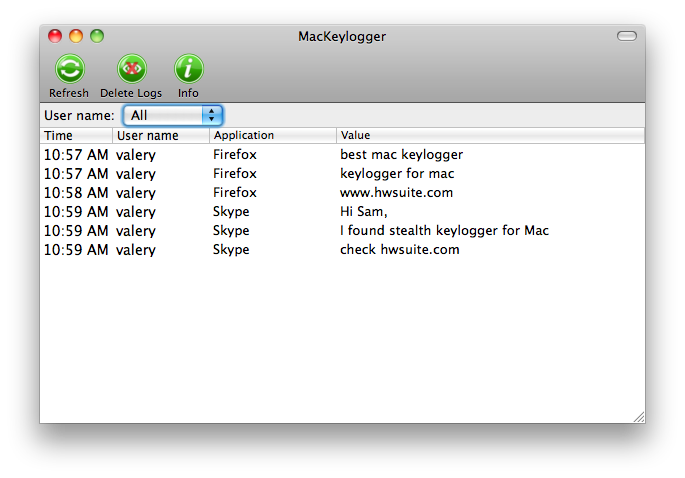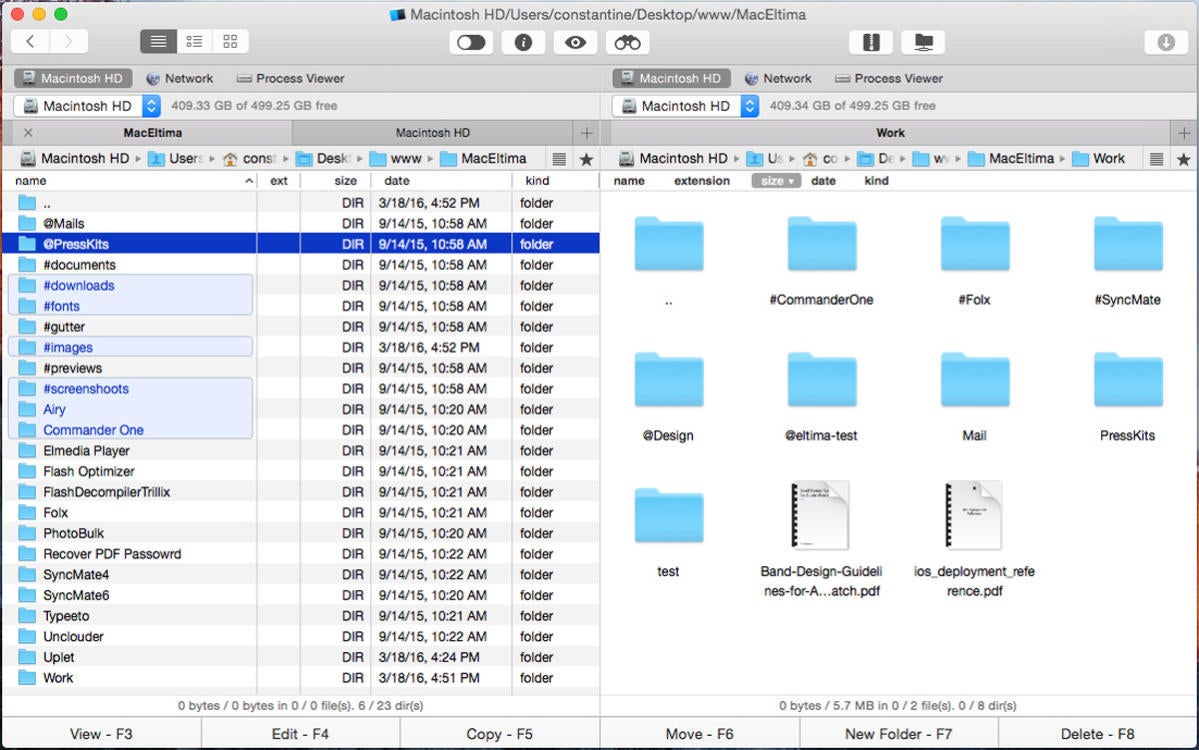Any keylogger for Mac was built from the ground-up for mac. It has one of the simplest interfaces of any product on this site, plain English and requires no tech-knowledge whatsoever to run. FEATURES: PASSWORD CAPTURE; CAPTURE SCREENSHOTS; MONITOR WEBSITES VISITED; LOG KEYSTROKES; TRACK APPLICATIONS; BLOCK APPLICATIONS; LIMIT PC TIME; CAPTURE CLIPBOARD. If that very idea scares you, take solace in the fact that for any keylogger to be effective, it has to first install properly in your computer. There are various categories of keyloggers, depending on the severity. Browser-based keyloggers: some malicious websites may use CSS scripts, Man-In-the-Browser (MITB) attacks, or web form-based.
Easy To Use Keyloggers
Keyloggers are a massive threat to users and the users’ data but as a Cyber Pro, you should be aware of how they work.
Are There Any Keyloggers For Mac Os
Content Written By Henry Dalziel, 2020
Keyloggers work by tracking the keystrokes of unsuspecting users and then the data is either stored locally or send via Bluetooth of WiFi back to the hacker.
The fears are obvious and for good reason.
Think about it for a second….hacking a computer remotely is difficult. But when you have physical access to the target machine then all bets are off – it becomes insanely simple.
These stealthy little USB hacking gadgets can easily slot into the back of any PC Tower (laptops also but they are very likely to be discovered) and then the job is done.
I’ve listed these tools for research purposes and please use them cautiously! You should also learn how to combat the usage of these devices in the workplace.
The following keylogging USB’s all come from Amazon and are very reasonably priced.
There’s little point doing a tutorial on how to use them because they are kinda obvious.
Is There A Keylogger Detection Tool or Method?
That is a fantastic question.
And – the answer is…not really…
The issue is this: these are devices that sit silently in the back of your PC Tower and software is, as far as I am aware, unable to detect that the USB Port has an illegally placed (hacking device) inserted into the machine.
The solution is this: use your eyes! Get used to looking behind your PC, Linux box or Mac frequently. Once you do it it will become habitual.
Always be suspicious and you’ll be ok.
There is another much more robust solution which is to use a screen-based keyboard because these keylogging devices are dependent on the user using a USB keyboard.
Why Would We Use A Keylogger? Are They Legal?
You’d use a keylogger for training purposes.
Here’s a typical use case: you’ve been commissioned to pentest a client. Two things you could do from the get-go (without telling them) is installing an Evil Twin using some WiFi hacking hardware, and plant a couple of these keylogging devices into the back of unsuspecting employees’ machines – preferably high targets. Such activity will generate results and will impress your client to the point that they’ll likely recommend and refer your skills.
KeyGrabber TimeKeeper USB 8GB
The first on our list is an absolute masterpiece at disguise.
It blends in like a chameleon.
This beauty just looks the part. It looks so innocuous and ubiquitous that it will almost certainly escape the attention of any unsuspecting boss at the workplace. The equally amazing thing about this particular keylogger is that it transmits the data back via a WiFi signal.
Each keystroke will be recorded by using a timestamp. It also ships with a massive 8 gig of data so you can be sure that the users’ every keystroke will be recorded for years to come. Like most of the other keyloggers in this list, this device does not need any drivers.
And, the scary thing is that for the most part, this keylogger is (I believe) Transparent to the computer operation, undetectable for security scanners.

Wi-Fi Premium USB MCP Hardware Keylogger 2GB
This one works on a mac!
Furthermore, it – and this is pretty unbelievable – emails automatic reports back to the hacker with recorded keyboard data!
This is almost designed for the world’s laziest hacker in mind.
Like the rest of the keyloggers in this list, it comes with a decent amount of storage and can go undetected for a long time, well at least until the target notices it.
KeyGrabber Pico USB 8GB
I’ve added this one on the list because it is TINY!
The way that it works is that you’d attach it to the back of the PC Tower (for example) and then place a regular USB male end into it.
Our understanding is that this is the smallest keylogger on the market, only 0.8″ (20 mm) long!
Keylogger Mini USB 3.0

This one definitely looks the best.
If you don’t want to get messy with configuring the device remotely, i.e. with hidden WiFi networks, Bluetooth, etc, then this is for you!
This would suit the Ethical Hacker that is able to have physical access to the targets machine at will.
The device works on Windows 7,8 and 10 and writes all keystrokes to a hidden file.
It should be noted however that this product does not work on Apple or Linux!
PenTap: Reset/Discover Windows Login Admin Password
This one is not strictly speaking a keyword logger but we thought to include it because it ought to belong in a pentester’s toolkit. This device can discover admin passwords for Windows Boxes including Windows 10, Windows 7, and Previous Versions. For the cost of this device, it is really worth it.
Again with a device like this you have to imagine yourself with a client: they will be in awe at the ease at which you can obtain their password. Of course, test it first to make sure it all works.
If you’re worried that your Mac’s keyboard is being recorded by a keylogger there are a number of steps you can take to find out and then remove it.
How do keyloggers work?
Keyloggers record the keystrokes typed on your Mac’s keyboard. There are two types of keyloggers, sofware- and hardware-based, which connect to a USB port on your Mac. Once the keystrokes have been recorded, anyone with access to the keylogger can see what has been typed on the keyboard, including usernames, passwords, bank details, and the content of instant messages and emails. Hackers use keyloggers to do just that.

Who uses keyloggers?
There are lots of instances where keyloggers can be used, from parents who want to monitor their children’s computer use or companies that want to snoop on employees, to hackers who use them to try and discover passwords.
While there are lots of legitimate (depending on your point of view) uses of keyloggers, there are also lots of ways in which they’re used unethically and in some cases illegally, so it’s important to know how to protect your Mac.
Can Macs get keyloggers?
Yes, there are several keyloggers available for the Mac. Known Mac keyloggers include Aobo Mac Keylogger, Refog Keylogger, and Spyrix Keylogger for Mac. They are among the top 10 Mac keyloggers.
Are There Any Keyloggers For Mac Windows 10
How to check your Mac for keyloggers
The first thing to do is to check for a hardware keylogger. This is likely to be plugged into your keyboard or somewhere between your keyboard and your Mac –if you use an external keyboard.
If there’s no sign of a hardware keylogger, the next step is to launch Activity Monitor.
- Go to Applications>Utilities and double-click Activity Monitor
- Check for processes that look like they might be keyboard loggers
- If you find one, write down its name
- Go to Applications>Utilities and launch Terminal
- Type: man [name of process] – where [name of process] is the process you wrote down. Type it’s name without the square brackets
- You should see a description of the process in the Terminal window
If the keyboard logger was installed by malware, it will likely be sending back the log of keystrokes to a remote server, known as ‘phoning home’. You can check for this by using an app called Little Snitch, which alerts you whenever a process on your Mac phone’s home and allows you to block it.
What should I do if I find a keyboard logger?
There are two possibilities if you find a keyboard logger on your Mac: that someone put it there deliberately by sitting in front of your Mac and fitting or installing it, or that you downloaded malware that contained the keyboard logger. In the latter situation, you should attempt to remove it using the steps below. However, if it was installed by, say an employer on your work Mac, you should speak to them.
How to remove a keylogger

If the keyboard logger was installed via malware, you can get rid of it using antivirus software. There are several antivirus tools for Mac, like BitDefender or Avast, for example, that you can download free and use to scan your Mac. Depending on the application, you may then have to pay for a full version to get rid of any malware it finds.
Another option is to use CleanMyMac X. CleanMyMac X has a malware removal tool that has a regularly-updated database of known malicious code. You can use that to scan your Mac at the press of a button. If CleanMyMac X finds anything, all it takes as a press of another button to remove it.
If you’ve tried running a malware removal or antivirus tool and still suspect you may have a keylogger on your Mac, your next option might be to perform a clean install of macOS. Make sure you backup your data before you do. But don’t restore from the backup — that will reinstall the keylogger. Instead, once you’ve erased your boot drive and reinstalled the OS, start installing applications one by one, then copy your data manually from the backup.
How can I protect my Mac from keyloggers?
You can protect your Mac from hardware keyloggers by never leaving it unattended. That may not be possible, of course, especially in a work environment, so if you suspect someone will attempt to fit one, check your Mac every time you return to it.
Keylogger For Mac Os X
Implementing the usual common sense approach to using your Mac will also help protect you from keyloggers, since those downloaded as malware rely on your clicking a link to download them.
- Don’t click in a link in any email message unless you’re certain where the email has come from and where the link leads.
- Install an ad-blocker in your web browser
- Heed the warning if your browser tells you a site you’re about to visit is unsafe
- Ignore pop-ups telling you that you need to update Flash or any other part of your Mac
- Use strong passwords and keep them safe in a password manager, rather than writing them down
- Use CleanMyMac X or an antivirus tool to scan your Mac regularly
Are There Any Keyloggers For Mac Computers
Discovering a keylogger on your Mac is at best unsettling and at worst, distressing, particularly if you don’t know who put it there or why. However, there are several ways to remove it, whether it’s hardware or software. And once you’ve got rid of it, using the steps described above should makes sure you never have to worry about finding one again.
